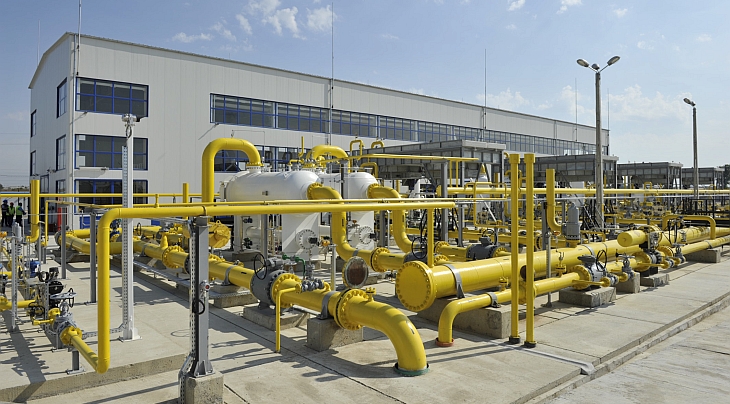Eastern European nations from Poland to Serbia are boosting stockpiles of natural gas after Russia reduced deliveries during the armed conflict in Eastern Ukraine and concerns rose about a winter shutoff, according to Bloomberg.
Romania has a significant domestic production and gas volumes already stored in warehouses are currently at 2.5 billion cubic meters, and they will reach close to 2.8 bcm, in the coming weeks. Minister for Energy, Razvan Nicolescu, announced that Romania has enough natural gas for the winter and that the imports of Russian gas are insignificant; so any ceasing in Russian gas deliveries will not affect consumers. The official also said the Hidroelectrica’s storage lakes are currently at about 95% capacity, and that the recently concluded investment of Trangaz in Urziceni has improved the total underground storage capacity and extraction for Romania.
Gas supplies to Romania from the Russian Federation were reduced last Friday by 5% from what planned, without any official explanation from Gazprom. One day before, gas companies in Poland and Slovakia have also announced that Russian gas supplies were reduced by 24% and 10%, respectively, of the contracted volumes.
Underground storage in the Czech Republic and Poland is at full capacity, while Slovakia expects to top up its storage facilities in the next several days, the countries” gas companies said. Serbia, whose sole depot has a capacity of 450 million cubic meters, may ask neighboring Hungary to store as much as 200 million cubic meters of gas in its reservoirs, according to Energy Minister Aleksandar Antic.
While the level of eastern European countries’ dependence on Russian gas through Ukraine varies, the region as a whole relies more on deliveries from OAO Gazprom (OGZD) than western Europe and is therefore stocking up in case flow from Russia via Ukraine stops entirely. During the past few days, Russia began slightly reducing supplies to countries like Slovakia and Poland, which provide reverse gas flows to Ukraine.
“Only Latvia has enough storage capacity to survive through the winter without Russian gas,” Mikhail Korchemkin from East European Gas Analysis said by e-mail. “Other countries of central and eastern Europe don’t have enough storage capacity.”
Southeastern European nations such as Bulgaria and Serbia are particularly exposed to interruptions since they are almost 100 percent dependent on Russian gas coming through Ukraine. The current crisis has rekindled memories of 2006 and 2009, when Gazprom disputes with Ukraine left the Balkan nations without fuel for weeks.
As a result, southeastern Europe’s governments were long reluctant to halt preparatory work on Gazprom’s South Stream project, designed to run under the Black Sea from Russia and enter the EU in Bulgaria, bypassing Ukraine.
Authorities were betting on the 2,446-kilometer (1,520-mile) pipeline to boost the security of supplies and halted the construction under lobbying from Brussels and the U.S. earlier this year.
The U.S. expanded sanctions against Russia today to include the country’s largest bank, OAO Sberbank, as well as energy, defense and technology companies owned by the state. Treasury Secretary Jacob J. Lew warned of Russia’s growing “economic and diplomatic isolation.”
In Serbia, where hundreds of thousands of households rely partly or completely on electricity for heating due to capped electricity prices, a gas shortage could cause a spike in power consumption that would destabilize the national grid, former Energy Minister Petar Skundric said. In case of a cutoff, Serb storage may cover as much as 45 days of consumption in wintertime.
The Czech Republic’s gas storage is full, one month before schedule, according RWE AG (RWE), which operates 92 percent of the country’s underground storage with a capacity of 2.7 billion cubic meters. Polish utility Polskie Gornictwo Naftowe i Gazownictwo SA also filled its 2.6 billion cubic meters of to the limit.
Still, gas companies across eastern Europe are reporting reduction in gas supplies from Russia. PGNiG said it received as much as 24 percent less gas from Gazprom than it ordered on Sept. 8 and 9. Slovakia, which started the reverse flow to Ukraine at the beginning of September, saw a 10 percent decrease in the amount of gas ordered from Russia every day since Sept. 10, operator Slovensky Plynarensky Priemysel AS said. Gas flow to Romania was cut by 5 percent.
Emerging Europe
“We are seeing a similar story across emerging Europe – Poland, Slovakia, Hungary and Romania, as Russia tries to limit any surplus gas available in the region for reverse flow back to Ukraine,” said Timothy Ash, the chief economist for emerging markets at Standard Bank Group Ltd. in London.
Slovakia’s SPP said so far the supplies are sufficient to cover all of the country’s demand and the storage is almost full.
Gas supplies to Austria were also 15 percent lower than agreed yesterday and will remain at the same level today, OMV AG spokesman Robert Lechner said in a phone interview today. The Austrian oil company is getting more gas than what’s needed and its own gas storages are 98 percent full, Lechner said.
